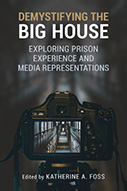Demystifying The Big House: Exploring Prison Experience And Media Representations

Editor: Katherine A Foss
Publisher: Carbondale, IL: Southern Illinois University Press, 2018. 366p.
Reviewer: Suzanne Bouclin | March 2019
Katherine A Foss has curated fourteen fascinating essays by emerging and established scholars who explore the mutually constitutive relationship between media representations and the lives of those who are housed within carceral institutions. Contributors “connect representation to experience” across disciplines and frameworks from sociology, criminology, communications and gender studies with essays that range from literary criticism to grounded ethnographic research.
Foss’s introduction engages with some of the scholarship from media studies and social sciences and provides the rationale for the collection’s organizational structure. Divided into three thematic sections, each with a guiding question and short theoretical framing, Demystifying the Big House begins with six cultural analyses of the existing prison representations. These chapters dovetail nicely with my own work at the intersection of law and the Women in Prison genre (Bouclin, 2007, 2009, 2010) in which I argue that the representations of incarcerated women may be a site of women’s legal subjectivity and agency. I have always maintained that the best WIP films leave us feeling unsettled about prisons and about the crimes with which these women have been accused. Yet, the consensus throughout the contributions in the first section seems to be that despite this rich potential, the range of meaningful representations is still quire narrow (see: Bratten; Kern; Jenkins & Wolfgang; Foss; and Schneeweis). These essays are thought-provoking and add depth to the expanding body of scholarship around prison (mis)representations. I found S. Lenise Wallace’s framing of the reality TV series Prison Wives, as a space where the voices of family members may be amplified, without exploitation or sensationalizing particularly provocative and compelling.
The second section shifts to the presence of media within carceral institutions; the third to experiential accounts of prison life. These contributions are, in my view, what demarcates this collection from other excellent projects also devoted to exploring the ramifications of distorted images of prison life in popular media (e.g., Jackson & Gordy, 2018). Specifically, Foss has brought together prison stories told from the standpoint of people on death row who have had their executions halted (Plec), prisoners who use art to construct more complex narratives about their experiences (Churcher, Chapter 8), and women incarcerated for violent crimes (Dye; Whiteley). Other contributors explore the various identities (e.g., as mothers: Cook) and social locations (e.g., as transgender people: Jenness & Fenstermaker; or as formerly criminalized people: Patrick) that incarcerated individuals, their families and allies navigate (Matthey),
Foss closes the collection by highlighting some recurring themes such as the overrepresentation of racialized groups, poor people and other marginalized communities in the carceral system and the on-going barriers to producing meaningful ethnographic research that document such injustices. She suggests one tool among a larger arsenal to be used in dismantling the prison-industrial complex: “The more media scholars and producers are aware of racial and gender hegemonies channeled through prison representations and news stories, the more these texts can be changed so that disparities can be corrected and the public can finally understand the complexities that pervade the criminal justice system” (335). The implication is that with this greater understanding, we may be motivated to work toward deep structural transformation of the methods we as a society use to deal with conflict and inequality.
Dr Suzanne Bouclin, Associate Professor, Faculty of Law, University of Ottawa


